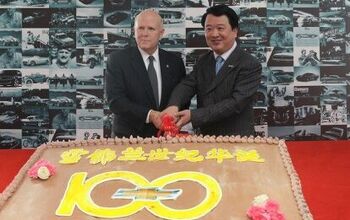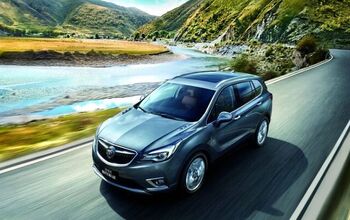GM Officially Out Of Control In China

Everybody who’s ever worked in China knows that some things take some time. Nothing that is announced today, happens tomorrow. There are applications to be made, documents to be “chopped.” Sometimes, this process takes forever, as it seems to be the case with Hummer. Sometimes, things move a bit faster. Last December, we reported that GM would sell a crucial one percent of the 50:50 holdings of GM China to their joint venture partner SAIC to bring the shareholdings to 51 percent SAIC, 49 percent GM.
As China’s new year (that of the tiger) came around, China’s biggest automaker SAIC Motor Corp has won regulatory approval to acquire the crucial 1 percent stake in Shanghai GM, Shanghai Daily reports today via Gasgoo. The matter has been officially filed to the Shanghai Stock Exchange yesterday. It’s official now. General Motors officially has been relegated to minority shareholder in its key venture in the world’s largest auto market. SAIC is now calling the shots.
SAIC makes a charitable donation of $85m for the crucial 1 percent share. According to yesterday’s filing, the added 1 percent enables SAIC to consolidate the joint venture’s results into SAIC’s balance sheet. This makes the bargain price even more astonishing.
When the deal was announced in December, it also became public that SAIC had more or less given SAIC half of GM’s business in India. India is an important growth market. India had successfully kept China out of the country. The deal with GM gave SAIC, and by extension China, backdoor access to a strategically important market.
Again, the price of admission was very low for SAIC. GM basically sold half of their India business for anywhere between $300m to $530, by way of an investment vehicle still to be set up in Hong Kong, which will take over GM India. That money will go right back into the Indian operation, which hadn’t been doing so well.
For chump change, GM is giving up control of a very successful venture in the world’s largest auto market. For a contribution to keep the lights on in India, GM gives SAIC in China coveted access to a country they would not have been able to penetrate alone. While something of great value is practically given away, GM is asking tax payers in the U.S.A. and Europe for money to keep them afloat. Why aren’t they ask China for money for something China urgently needs and wants? What’s going on here?

Bertel Schmitt comes back to journalism after taking a 35 year break in advertising and marketing. He ran and owned advertising agencies in Duesseldorf, Germany, and New York City. Volkswagen A.G. was Bertel's most important corporate account. Schmitt's advertising and marketing career touched many corners of the industry with a special focus on automotive products and services. Since 2004, he lives in Japan and China with his wife <a href="http://www.tomokoandbertel.com"> Tomoko </a>. Bertel Schmitt is a founding board member of the <a href="http://www.offshoresuperseries.com"> Offshore Super Series </a>, an American offshore powerboat racing organization. He is co-owner of the racing team Typhoon.
More by Bertel Schmitt
Latest Car Reviews
Read moreLatest Product Reviews
Read moreRecent Comments
- Kjhkjlhkjhkljh kljhjkhjklhkjh A prelude is a bad idea. There is already Acura with all the weird sport trims. This will not make back it's R&D money.
- Analoggrotto I don't see a red car here, how blazing stupid are you people?
- Redapple2 Love the wheels
- Redapple2 Good luck to them. They used to make great cars. 510. 240Z, Sentra SE-R. Maxima. Frontier.
- Joe65688619 Under Ghosn they went through the same short-term bottom-line thinking that GM did in the 80s/90s, and they have not recovered say, to their heyday in the 50s and 60s in terms of market share and innovation. Poor design decisions (a CVT in their front-wheel drive "4-Door Sports Car", model overlap in a poorly performing segment (they never needed the Altima AND the Maxima...what they needed was one vehicle with different drivetrain, including hybrid, to compete with the Accord/Camry, and decontenting their vehicles: My 2012 QX56 (I know, not a Nissan, but the same holds for the Armada) had power rear windows in the cargo area that could vent, a glass hatch on the back door that could be opened separate from the whole liftgate (in such a tall vehicle, kinda essential if you have it in a garage and want to load the trunk without having to open the garage door to make room for the lift gate), a nice driver's side folding armrest, and a few other quality-of-life details absent from my 2018 QX80. In a competitive market this attention to detai is can be the differentiator that sell cars. Now they are caught in the middle of the market, competing more with Hyundai and Kia and selling discounted vehicles near the same price points, but losing money on them. They invested also invested a lot in niche platforms. The Leaf was one of the first full EVs, but never really evolved. They misjudged the market - luxury EVs are selling, small budget models not so much. Variable compression engines offering little in terms of real-world power or tech, let a lot of complexity that is leading to higher failure rates. Aside from the Z and GT-R (low volume models), not much forced induction (whether your a fan or not, look at what Honda did with the CR-V and Acura RDX - same chassis, slap a turbo on it, make it nicer inside, and now you can sell it as a semi-premium brand with higher markup). That said, I do believe they retain the technical and engineering capability to do far better. About time management realized they need to make smarter investments and understand their markets better.


































Comments
Join the conversation
You'll never loose money betting on GM executive ability to make the wrong decision at the right time. After all, their rare talents led the world's biggest and most quality car manufacturer to it's present position of building junkmobiles for the government.
I think we can stick a fork in Hummer now. http://jalopnik.com/5479428/gm-kills-hummer-officially http://www.autoblog.com/2010/02/24/hummer-gm-sale-tengzhong-wind-down/ And that sound you hear is Greenpeace celebrating.